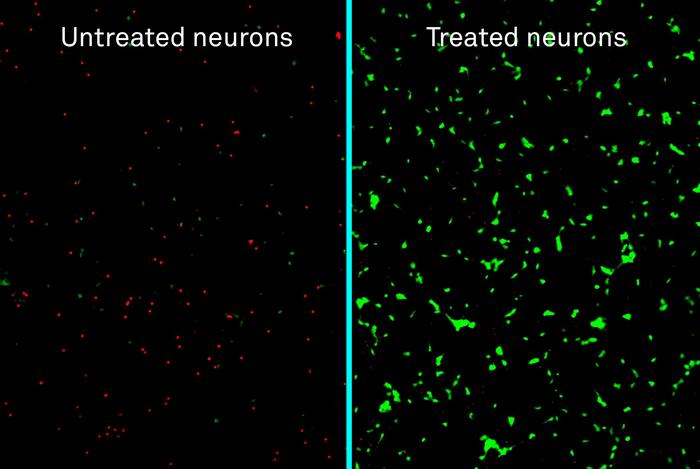
Scientists at Northwestern University have achieved a significant breakthrough in the fight against neurodegenerative diseases, specifically targeting conditions such as Alzheimer’s disease and amyotrophic lateral sclerosis (ALS). These illnesses are notorious for their devastating impact, characterized by the misfolding and aggregation of proteins around neurons, ultimately leading to cell death. In response to this alarming issue, the researchers developed a novel treatment that effectively intercepts these rogue proteins before they can form toxic aggregates that infiltrate and damage neurons. By utilizing a unique “clean-up” strategy, this innovative approach has been shown to dramatically enhance the survival rates of lab-cultured human neurons exposed to the harmful effects of these disease-associated proteins.
The process employed in this new treatment revolves around the use of molecularly engineered nanomaterials, marking a groundbreaking advancement in the field of regenerative medicine. The study’s senior author, Professor Samuel I. Stupp, emphasizes the potential of these nanomaterials to address the underlying causes of neurodegenerative diseases. Stupp explains that in these disorders, misfolded proteins lose their functional conformation, leading to the formation of destructive structures that are highly toxic to neurons. By effectively trapping these proteins at an early stage, the new treatment inhibits the formation of toxic amyloid fibers believed to be responsible for neuronal damage.
This transformative approach gained recognition when it was designated as an ACS Editor’s Choice article, slated for publication in the prestigious Journal of the American Chemical Society. The collaborative research team, led by Stupp, aimed to devise a method that not only combats the toxicity associated with misfolded proteins but does so in a way that harnesses the body’s natural processes for breaking down harmful substances. The researchers report that by employing peptide amphiphiles—synthetic molecules that mimic natural biomolecules—the treatment facilitates the capture and degradation of disease-causing proteins within the body.
Peptide amphiphiles have a history of therapeutic application, with prior success in promoting insulin production. In developing a new peptide amphiphile for the treatment of neurodegenerative diseases, the research team introduced a natural sugar, trehalose, known for its protective properties against various biological stresses. Trehalose, which occurs widely in nature, acts not only as a stabilizing agent for proteins but also shows promise in enhancing the effectiveness of the therapy. By incorporating trehalose into the peptide amphiphile framework, the scientists aimed to create a more dynamic nanofiber structure capable of interacting with harmful misfolded proteins.
Interestingly, the presence of trehalose also resulted in a decrease in the stability of the nanofibers, a counterintuitive finding that ultimately proved beneficial. The researchers discovered that less stable nanofibers exhibit heightened reactivity, making them more likely to seek out and engage with misfolded proteins. The resulting interactions led to the integration of toxic amyloid-beta proteins, a significant contributor to Alzheimer’s disease, into the nanofibers’ structure. By permanently trapping these harmful proteins, the therapy prevents their infiltration into neuronal cells, thereby safeguarding neuron integrity and functionality.
In laboratory tests involving human neurons derived from stem cells, the results demonstrated remarkable improvements in neuron survival rates when exposed to the trehalose-coated nanofibers. This innovative approach may pave the way for a new generation of therapies targeting neurodegenerative conditions. As the research team notes, the application of unstable, reactive nanofibers to entrap toxic proteins offers a promising strategy for combating diseases like Alzheimer’s and ALS. Stupp indicates that this therapy may have the most profound effects when used at earlier stages of neurodegenerative diseases, before aggregated proteins gain access to cells and cause irreversible damage.
Drawing comparisons to cancer therapies that often incorporate multiple treatment modalities, Stupp suggests that the nanotherapy could be synergistic when combined with existing and emerging treatments targeting later-stage symptoms of neurodegenerative diseases. This holistic treatment paradigm could represent a game-changing approach in the management of conditions that currently lack effective treatment options. The research not only showcases the extraordinary potential of peptide-based therapies but also highlights the ongoing need for innovation in the face of neurodegenerative diseases that afflict millions worldwide.
Moreover, the exploratory nature of this research indicates a broader application potential. If the nanotherapy proves successful in patients, it could revolutionize how neurodegenerative diseases are treated, shifting the focus toward preventive treatments that delay the onset or progression of symptoms. Through ongoing collaboration and investigation, the potential for these molecularly engineered nanomaterials to reshape the landscape of neurotherapeutics is on the horizon.
The foundational study, titled “Supramolecular copolymerization of glycopeptide amphiphiles and amyloid peptides improves neuron survival,” received support from several prominent institutions, underscoring the collaborative effort fueling this groundbreaking research. By championing innovative approaches that encompass molecular engineering and bioengineering, the team at Northwestern University continues to illuminate pathways toward better understanding and treating neurodegenerative diseases.
Subject of Research: Cells
Article Title: Supramolecular copolymerization of glycopeptide amphiphiles and amyloid peptides improves neuron survival
News Publication Date: May 14 (upcoming)
Web References: (not provided)
References: (not provided)
Image Credits: Credit: Samuel Stupp Laboratory/Northwestern University
Keywords
Neurodegenerative diseases, Amyotrophic lateral sclerosis, Alzheimer disease, Neuroprotection, Biomaterials, Regenerative medicine, Nanomedicine, Drug development, Neuropharmacology, Drug design.
Tags: Alzheimer’s disease researchamyotrophic lateral sclerosis therapyclean-up strategy for neurodegenerationinnovative Alzheimer’s treatmentslab-cultured human neuronsmolecularly engineered nanomaterialsnanotherapy for neuron survivalneurodegenerative diseases treatmentneuron protection strategiesprotein aggregation in neuronsregenerative medicine breakthroughstoxic protein misfolding





